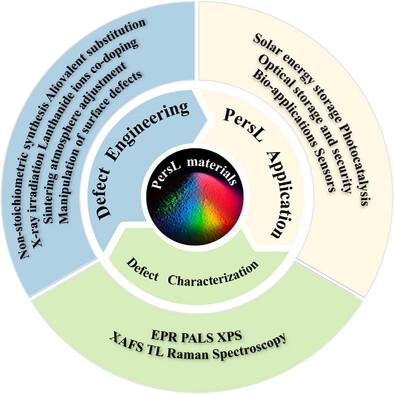持续发光材料缺陷的研究进展
IF 19
1区 材料科学
Q1 CHEMISTRY, MULTIDISCIPLINARY
引用次数: 0
摘要
持续发光(PersL)材料在激发停止后继续发光,在各种应用中引起了极大的关注。作为阱中心,缺陷在激发过程中通过捕获和存储载流子(电子或空穴)在激活和调制PersL中起核心作用。这些陷阱的类型、深度、分布和密度决定了载流子的释放特性和动力学,从而决定了PersL的波长、强度和持续时间。尽管对PersL进行了广泛的研究,但是缺乏专门关注缺陷角色的全面审查。在此,我们概述了personl的组成和机制,然后系统地探讨了缺陷的类型、常见的表征方法、它们对personl性能的影响以及用于personl优化的缺陷工程策略。在重点介绍了缺陷引导设计的持久性发光纳米粒子(PLNPs)之后,总结了缺陷第一性原理建模的进展,以及PersL材料的代表性应用。我们以讨论当前的挑战和对高性能personl系统的缺陷控制策略的观点作为结束。本文章由计算机程序翻译,如有差异,请以英文原文为准。

Recent Studies of Defects in Persistent Luminescent Materials
Persistent luminescent (PersL) materials, which continue emitting light after the excitation is ceased, have garnered significant attention for diverse applications. As trap centers, defects play a central role in enabling and modulating PersL by capturing and storing charge carriers (electrons or holes) during excitation. The type, depth, distribution, and density of these traps govern the release features and dynamics of charge carriers, and consequently dictate the wavelength, intensity, and duration of PersL. Despite extensive research on PersL, a comprehensive review specifically focusing on the role of defects is lacking. Herein, we provide an overview of the composition and mechanisms of PersL, followed by systematic explorations on the types of defects, common characterization methods, their impact on PersL performance, and defect engineering strategies for PersL optimization. After highlighting defect-guided design of persistent luminescent nanoparticles (PLNPs), advances in first-principles modeling of defects, and representative applications of PersL materials are summarized. We end with discussing current challenges and perspectives on defect control strategies toward high-performance PersL systems.
求助全文
通过发布文献求助,成功后即可免费获取论文全文。
去求助
来源期刊

Advanced Functional Materials
工程技术-材料科学:综合
CiteScore
29.50
自引率
4.20%
发文量
2086
审稿时长
2.1 months
期刊介绍:
Firmly established as a top-tier materials science journal, Advanced Functional Materials reports breakthrough research in all aspects of materials science, including nanotechnology, chemistry, physics, and biology every week.
Advanced Functional Materials is known for its rapid and fair peer review, quality content, and high impact, making it the first choice of the international materials science community.
 求助内容:
求助内容: 应助结果提醒方式:
应助结果提醒方式:


